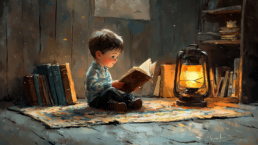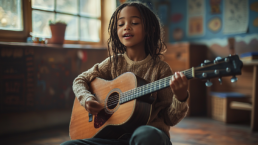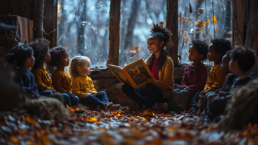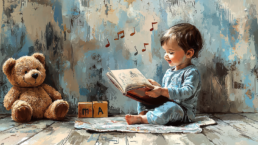Tell Me a Story I Can Feel: The Power of Interactive Storytelling in Early Learning
Tell Me a Story I Can Feel: The Power of Interactive Storytelling in Early Learning
Every kid loves a good story—but when they get to be part of the story? Ohhh now it’s a whole event.
Interactive storytelling isn’t just fun. It’s foundational. When children get to move, sing, clap, or respond while a story unfolds, it transforms listening into learning. And trust—this kind of engagement sticks way deeper than passive storytime.
Here’s why interactive storytelling is a game-changer:
It Builds Brain + Body Connections
When kids act out parts of a story or add sound effects with instruments or claps, they’re not just playing—they’re building memory, coordination, and comprehension all at once.
It Boosts Confidence and Language Skills
Asking kids to repeat lines, guess what happens next, or even play a character gives them room to express themselves. This ain’t just cute performance—it’s social-emotional learning in real time.
Music + Story = Supercharged Attention
When a story has rhythm, rhyme, or a catchy chorus, kids are way more likely to stay focused. Songs woven into stories also help with sequencing and memory—like remembering what happened first, next, and last.
It Sparks Imagination and Critical Thinking
“Why do you think the bear went into the cave?” That one question can light up a child’s entire inner world. Now you’re not just telling a story—you’re creating space for curiosity.
Try This Out:
- Use props! Scarves, puppets, and musical instruments bring stories to life.
- Let the kids create sound effects with drums, shakers, or even their voices.
- Turn books into mini-plays where each child gets a role.
- Ask open-ended questions as you go: “What do you think happens next?” or “How would you solve that problem?”
When children experience a story, they don’t just hear it—they live it. And that makes all the difference in how they understand the world around them.
Interactive storytelling brings literacy, movement, music, and imagination into one joyful package. And that? That’s where the real magic happens.
About Little Scholars Network
“Little Scholars Network creates fun, engaging educational content to help kids learn through music, movement, and vibrant animation. Watch our episodes on YouTube and Amazon!”
Latest Post
How Music Helps Kids Learn Faster
February 24, 2025
Why Learning Through Music Boosts Early Childhood Development
February 25, 2025
Interactive Storytelling: How It Helps Children Learn Better
February 25, 2025
The Importance of Early Literacy in Childhood Education
February 26, 2025
The Rhythm of Routine: Using Music to Build Structure in a Child’s Day
The Rhythm of Routine: Using Music to Build Structure in a Child’s Day
Let’s face it—getting little ones to follow a daily routine can be a full-on adventure. One moment you’re brushing teeth, the next you’re negotiating with a 3-year-old about why pants are non-negotiable. But what if I told you music could turn chaos into calm?
Yep, music isn’t just for dance parties. It’s a low-key superpower when it comes to building structure and rhythm in a child’s day. When routines are paired with melodies, they become less of a battle and more of a vibe.
Here’s why musical routines just hit different:
Consistency They Can Feel
Kids respond to rhythm and repetition. A familiar “Time to Clean Up” song lets them know exactly what’s coming, without feeling like they’re being told what to do. It becomes a cue, not a command.
Making Memories Stick
Melodies are sticky. A catchy toothbrushing tune makes it easier for kids to remember each step—and makes the task way less boring.
Language and Listening Upgrade
Songs help develop language skills and auditory memory. Routines that involve singing or rhythm-based call-and-response build communication and focus.
Confidence Through Ownership
When kids can anticipate what’s next, they feel more in control of their world. That’s a big win in the confidence department.
Try This at Home or in the Classroom:
Build a simple “Routine Remix” playlist. Pick a few songs for key parts of the day—like waking up, cleaning up, mealtime, and bedtime. Keep ’em short and snappy. Bonus points if you make up your own lyrics based on your child’s name or favorite animals.
Before long, your child will start leading the routine. All because their brain recognizes the beat.
Music makes structure feel like a dance instead of a drill. And once you find that groove? Whew—game changer.
About Little Scholars Network
“Little Scholars Network creates fun, engaging educational content to help kids learn through music, movement, and vibrant animation. Watch our episodes on YouTube and Amazon!”
Latest Post
How Music Helps Kids Learn Faster
February 24, 2025
Why Learning Through Music Boosts Early Childhood Development
February 25, 2025
Interactive Storytelling: How It Helps Children Learn Better
February 25, 2025
The Importance of Early Literacy in Childhood Education
February 26, 2025
How to Make Letter Learning Fun at Home and in the Classroom
How to Make Letter Learning Fun at Home and in the Classroom
Engaging Young Learners Beyond the ABCs
Teaching the alphabet is more than just memorizing letters—it’s about creating experiences that help children connect letters to sounds, words, and meaning. Whether you’re a parent working on early literacy at home or a teacher looking for fresh classroom ideas, there are simple ways to make letter learning engaging, effective, and fun!
Make It Interactive
Children learn best when they use multiple senses. Instead of just reciting letters, add movement, texture, and sound to the experience.
- Letter Hunts: Hide letter flashcards around the room and have kids search for them, calling out the letters as they find them.
- Sensory Play: Use sand, shaving cream, or finger paint to let kids trace letters with their hands.
- DIY Letter Puzzles: Cut large letters out of cardboard and let children match them to pictures of objects that start with that letter.
Use Music and Rhythm
Songs are a powerful learning tool because they reinforce patterns and repetition—key components of memory. Alphabet songs, rhyming games, and rhythm-based activities make letter recognition easier and more enjoyable. Try:
- Clapping or tapping out syllables in words that start with the focus letter.
- Singing letter-based songs while incorporating simple hand movements.
- Using musical instruments to emphasize certain letter sounds.
Connect Letters to Everyday Life
The more kids see and use letters in real-world situations, the better they retain them. Parents and teachers can:
- Point out letters on street signs, cereal boxes, and book covers.
- Encourage kids to write letters in the air with their fingers.
- Play “I Spy” with letters, looking for objects that start with the letter of the day.
Final Thoughts
The key to successful letter learning is engagement and consistency. By making the process interactive, musical, and part of everyday experiences, both parents and teachers can help children build a strong foundation in early literacy—without it feeling like a chore!
About Little Scholars Network
“Little Scholars Network creates fun, engaging educational content to help kids learn through music, movement, and vibrant animation. Watch our episodes on YouTube and Amazon!”
Latest Post
How Music Helps Kids Learn Faster
February 24, 2025
Why Learning Through Music Boosts Early Childhood Development
February 25, 2025
Interactive Storytelling: How It Helps Children Learn Better
February 25, 2025
The Importance of Early Literacy in Childhood Education
February 26, 2025
Want to see this concept in action? Watch our fun, engaging educational videos!
The Importance of Early Literacy in Childhood Education


The Importance of Early Literacy in Childhood Education
Early literacy is a fundamental part of childhood education that lays the foundation for future learning. Research shows that 90% of brain development occurs before the age of five, making the early years critical for building strong reading and communication skills. Children who are exposed to books, spoken language, and print early in life develop better vocabulary, comprehension, and overall literacy skills as they grow. Understanding how to support early literacy can help parents and educators give young learners the tools they need to succeed.
What is Early Literacy?
Early literacy is more than just learning how to read—it involves developing an understanding of words, sounds, and symbols through everyday interactions. These foundational skills prepare children for reading and writing later on. Key aspects of early literacy include:
Letter Recognition
Recognizing and identifying letters helps children connect written symbols to spoken language.
Phonemic Awareness
Understanding the relationship between letters and sounds strengthens language comprehension and pronunciation.
Print Awareness
Learning how books work, such as turning pages and following words from left to right, helps develop essential reading habits.
Children who engage with books and literacy activities at an early age build a stronger foundation for academic success.
How to Encourage Early Literacy?
Parents and caregivers can support early literacy development in simple ways:
- Read Together Daily – Reading even a few minutes a day helps children develop a love for books and stories.
- Use Songs & Rhymes – Singing nursery rhymes and songs enhances word recognition and memory.
- Make Learning Fun – Educational games, storytelling, and interactive videos help reinforce early literacy concepts.
At Little Scholars Network, we create high-quality educational content that supports early literacy through engaging stories, music, and activities. Stay connected for new interactive videos, eBooks, and learning resources designed to help children build strong literacy skills from an early age.
Follow us for more tips and resources on early childhood learning!
Latest Post
How Music Helps Kids Learn Faster
February 24, 2025
Why Learning Through Music Boosts Early Childhood Development
February 25, 2025
Interactive Storytelling: How It Helps Children Learn Better
February 25, 2025
The Importance of Early Literacy in Childhood Education
February 26, 2025
How Music Helps Kids Learn Faster
How Music Helps Kids Learn Faster
Music is a powerful tool in early childhood education. It engages young minds, strengthens memory, and makes learning more enjoyable. Research shows that rhythm, repetition, and melody improve cognitive development by reinforcing key concepts in a fun and interactive way. When children sing along to educational songs, they not only enjoy the experience but also absorb and retain information more effectively.
Why Music Supports Learning
-
Rhythm Enhances Memory – Songs with steady beats help children process and recall information. The rhythmic structure provides a predictable pattern, making it easier to remember words, numbers, and sequences.
-
Repetition Reinforces Concepts – Children learn best through repetition. Hearing the same sounds and phrases multiple times strengthens neural connections, improving recognition of letters, numbers, and colors.
-
Melody Engages the Brain – Melodic patterns create associations between sounds and meaning, helping children recognize phonetics and develop stronger language skills. Singing along encourages active participation, reinforcing what they learn.
How Little Scholars Network Uses Music for Learning
At Little Scholars Network, we integrate music into our educational content to teach letters, numbers, colors, and shapes. Our songs use engaging melodies and repetition to help children grasp foundational concepts effortlessly.
🎵 Our ABC Song introduces children to the alphabet through a fun and interactive tune.
🎶 Our Counting Songs (1-5, 6-10, etc.) make learning numbers exciting by pairing them with movement and rhythm.
Through music, children build confidence in their learning abilities while developing early literacy and numeracy skills.
Start Learning with Music Today!
Give your child a head start by incorporating music into their daily routine. Watch our engaging educational videos on YouTube & Amazon to see how music makes learning faster and more enjoyable!
About Little Scholars Network
“Little Scholars Network creates fun, engaging educational content to help kids learn through music, movement, and vibrant animation. Watch our episodes on YouTube and Amazon!”
Latest Post
How Music Helps Kids Learn Faster
February 24, 2025
Why Learning Through Music Boosts Early Childhood Development
February 25, 2025
Interactive Storytelling: How It Helps Children Learn Better
February 25, 2025
The Importance of Early Literacy in Childhood Education
February 26, 2025










